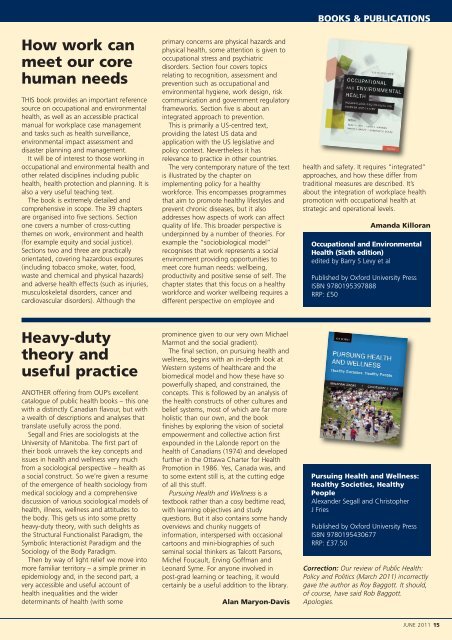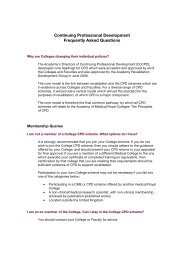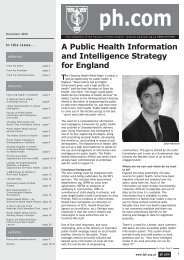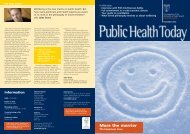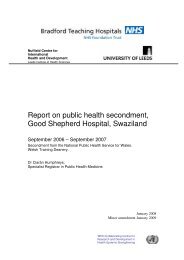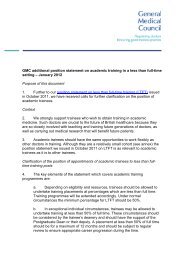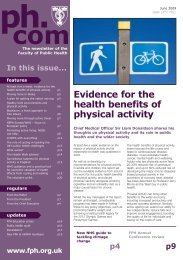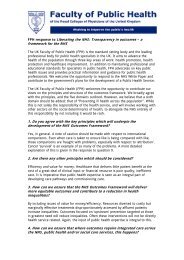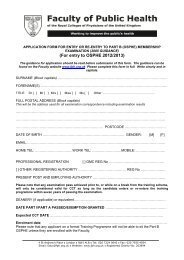PHT June 2011_Jan 10 - UK Faculty of Public Health
PHT June 2011_Jan 10 - UK Faculty of Public Health
PHT June 2011_Jan 10 - UK Faculty of Public Health
Create successful ePaper yourself
Turn your PDF publications into a flip-book with our unique Google optimized e-Paper software.
How work can<br />
meet our core<br />
human needs<br />
THIS book provides an important reference<br />
source on occupational and environmental<br />
health, as well as an accessible practical<br />
manual for workplace case management<br />
and tasks such as health surveillance,<br />
environmental impact assessment and<br />
disaster planning and management.<br />
It will be <strong>of</strong> interest to those working in<br />
occupational and environmental health and<br />
other related disciplines including public<br />
health, health protection and planning. It is<br />
also a very useful teaching text.<br />
The book is extremely detailed and<br />
comprehensive in scope. The 39 chapters<br />
are organised into five sections. Section<br />
one covers a number <strong>of</strong> cross-cutting<br />
themes on work, environment and health<br />
(for example equity and social justice).<br />
Sections two and three are practically<br />
orientated, covering hazardous exposures<br />
(including tobacco smoke, water, food,<br />
waste and chemical and physical hazards)<br />
and adverse health effects (such as injuries,<br />
musculoskeletal disorders, cancer and<br />
cardiovascular disorders). Although the<br />
primary concerns are physical hazards and<br />
physical health, some attention is given to<br />
occupational stress and psychiatric<br />
disorders. Section four covers topics<br />
relating to recognition, assessment and<br />
prevention such as occupational and<br />
environmental hygiene, work design, risk<br />
communication and government regulatory<br />
frameworks. Section five is about an<br />
integrated approach to prevention.<br />
This is primarily a US-centred text,<br />
providing the latest US data and<br />
application with the US legislative and<br />
policy context. Nevertheless it has<br />
relevance to practice in other countries.<br />
The very contemporary nature <strong>of</strong> the text<br />
is illustrated by the chapter on<br />
implementing policy for a healthy<br />
workforce. This encompasses programmes<br />
that aim to promote healthy lifestyles and<br />
prevent chronic diseases, but it also<br />
addresses how aspects <strong>of</strong> work can affect<br />
quality <strong>of</strong> life. This broader perspective is<br />
underpinned by a number <strong>of</strong> theories. For<br />
example the “sociobiological model”<br />
recognises that work represents a social<br />
environment providing opportunities to<br />
meet core human needs: wellbeing,<br />
productivity and positive sense <strong>of</strong> self. The<br />
chapter states that this focus on a healthy<br />
workforce and worker wellbeing requires a<br />
different perspective on employee and<br />
BOOKS & PUBLICATIONS<br />
health and safety. It requires “integrated”<br />
approaches, and how these differ from<br />
traditional measures are described. It’s<br />
about the integration <strong>of</strong> workplace health<br />
promotion with occupational health at<br />
strategic and operational levels.<br />
Amanda Killoran<br />
Occupational and Environmental<br />
<strong>Health</strong> (Sixth edition)<br />
edited by Barry S Levy et al<br />
Published by Oxford University Press<br />
ISBN 9780195397888<br />
RRP: £50<br />
Heavy-duty<br />
theory and<br />
useful practice<br />
ANOTHER <strong>of</strong>fering from OUP’s excellent<br />
catalogue <strong>of</strong> public health books – this one<br />
with a distinctly Canadian flavour, but with<br />
a wealth <strong>of</strong> descriptions and analyses that<br />
translate usefully across the pond.<br />
Segall and Fries are sociologists at the<br />
University <strong>of</strong> Manitoba. The first part <strong>of</strong><br />
their book unravels the key concepts and<br />
issues in health and wellness very much<br />
from a sociological perspective – health as<br />
a social construct. So we’re given a resume<br />
<strong>of</strong> the emergence <strong>of</strong> health sociology from<br />
medical sociology and a comprehensive<br />
discussion <strong>of</strong> various sociological models <strong>of</strong><br />
health, illness, wellness and attitudes to<br />
the body. This gets us into some pretty<br />
heavy-duty theory, with such delights as<br />
the Structural Functionalist Paradigm, the<br />
Symbolic Interactionist Paradigm and the<br />
Sociology <strong>of</strong> the Body Paradigm.<br />
Then by way <strong>of</strong> light relief we move into<br />
more familiar territory – a simple primer in<br />
epidemiology and, in the second part, a<br />
very accessible and useful account <strong>of</strong><br />
health inequalities and the wider<br />
determinants <strong>of</strong> health (with some<br />
prominence given to our very own Michael<br />
Marmot and the social gradient).<br />
The final section, on pursuing health and<br />
wellness, begins with an in-depth look at<br />
Western systems <strong>of</strong> healthcare and the<br />
biomedical model and how these have so<br />
powerfully shaped, and constrained, the<br />
concepts. This is followed by an analysis <strong>of</strong><br />
the health constructs <strong>of</strong> other cultures and<br />
belief systems, most <strong>of</strong> which are far more<br />
holistic than our own, and the book<br />
finishes by exploring the vision <strong>of</strong> societal<br />
empowerment and collective action first<br />
expounded in the Lalonde report on the<br />
health <strong>of</strong> Canadians (1974) and developed<br />
further in the Ottawa Charter for <strong>Health</strong><br />
Promotion in 1986. Yes, Canada was, and<br />
to some extent still is, at the cutting edge<br />
<strong>of</strong> all this stuff.<br />
Pursuing <strong>Health</strong> and Wellness is a<br />
textbook rather than a cosy bedtime read,<br />
with learning objectives and study<br />
questions. But it also contains some handy<br />
overviews and chunky nuggets <strong>of</strong><br />
information, interspersed with occasional<br />
cartoons and mini-biographies <strong>of</strong> such<br />
seminal social thinkers as Talcott Parsons,<br />
Michel Foucault, Erving G<strong>of</strong>fman and<br />
Leonard Syme. For anyone involved in<br />
post-grad learning or teaching, it would<br />
certainly be a useful addition to the library.<br />
Alan Maryon-Davis<br />
Pursuing <strong>Health</strong> and Wellness:<br />
<strong>Health</strong>y Societies, <strong>Health</strong>y<br />
People<br />
Alexander Segall and Christopher<br />
J Fries<br />
Published by Oxford University Press<br />
ISBN 9780195430677<br />
RRP: £37.50<br />
Correction: Our review <strong>of</strong> <strong>Public</strong> <strong>Health</strong>:<br />
Policy and Politics (March <strong>2011</strong>) incorrectly<br />
gave the author as Roy Baggott. It should,<br />
<strong>of</strong> course, have said Rob Baggott.<br />
Apologies.<br />
JUNE <strong>2011</strong> 15


